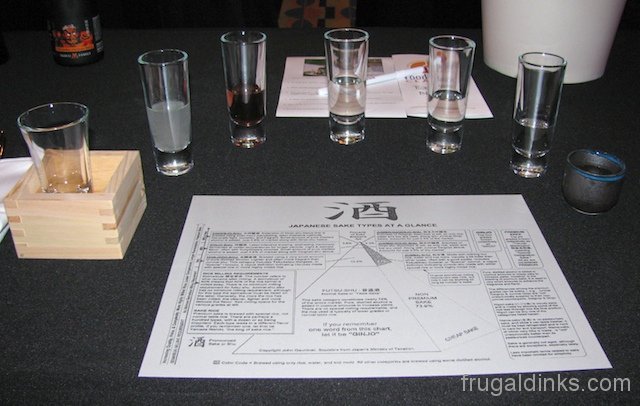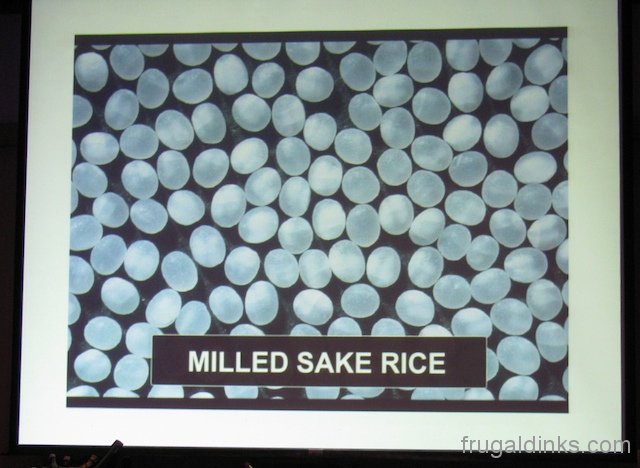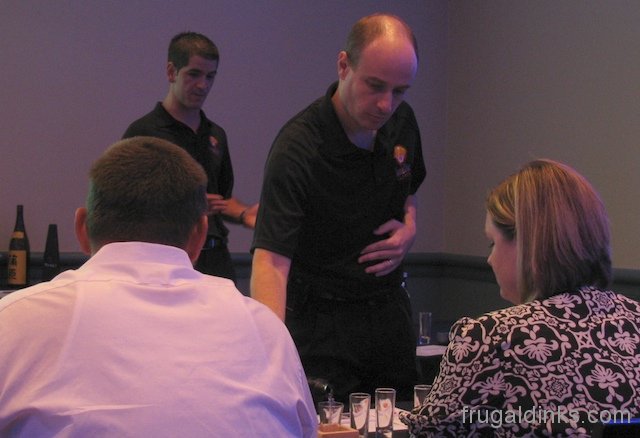All Things Sake
From Food & Wine Classic Preview Materials…
“Dive into the history of sake, the current trends in the industry, and a hint at what we can expect tomorrow. Topics include vessels, labeling, when to warm your sake and how the production and milling of sake produces different grades and taste profiles. This class will be filled with opportunities to taste many different types of sake and demonstrate how simple it is to pair with food. Kanpai!” Instructor: Chad Lobner, Kimonos Sushi Restaurant Manager

- Each tasting station was set up when we entered the room
Our Review:
When we signed up for the courses on the 8th and the 9th our top two choices were “Modern Mixology” and “Beer, Please!” — we were able to sign up for “Modern Mixology” without any problem but the “Beer, Please!” was booked solid for both nights. “All Things Sake” was our third choice as Nora really enjoys sake and we both enjoy Japanese food. We weren’t disappointed, in fact, we’re hoping to skip out of the “Mixology” course on the 9th and go back to “All Things Sake” again so that we can soak up more of the information.
First off, this course was really educational and we enjoyed it quite a bit. Chad did an excellent job and the other Swan/Dolphin staff were polite, courteous, and helpful. As promised, the seminar went into the history of sake, how sake is made, and how it is classified. We tasted seven sakes and two of these were paired with food tastings.

- Milling removes the bran, proteins, fats, and amino acids from the outer layers of a rice grain, leaving pure starch
Our Notes:
- Sake (which actually refers to any alcoholic drink) is closer to beer than it is to wines or distilled spirits
- 1300 sake breweries in Japan – number has greatly declined over the past century
- Sake as we know it today has been around for approximately 1000 years
- Basically, mold is added to cooked rice & water, it ferments & makes sake
- In 1969, the Japanese government banned additives in sake (thank goodness, apparently at one point, sake was so adulterated with nasty substances that, much like southern moonshine, it was pretty disgusting and dangerous stuff)
- The Levels of sake are a reflection of two factors: the milling of the rice and the addition of distilled alcohol
- Freshness is very important – unlike wine, sake isn’t going to get better if you store it in a cool dark place for years on end!
- Sake should be stored away from heat and light, but it doesn’t “age”
- Some sake will have a number ranging from -20 to +20 on the label
- Measure of the sugar content of the sake, hydrometer measurement actually
- “Higher is Drier”
- Chad says this doesn’t mean a whole lot because it doesn’t give you any information about the flavor profile of the sake
- Competitions judged by the Japanese Sake Tasting Board created the various levels of sake and their classifications
- Drinking Sake doesn’t come along with a lot of rules or traditions, in brief…
- You don’t pour sake for yourself, you pour for a friend or companion & they do the same for you
- Traditional vessels -I didn’t catch all of this, see, we need to go back again!
- An overflowing pour of sake is a sign of generosity
Levels of Sake (links here, here & here):
- Futsu-Shu — normal sake or “table sake” — it doesn’t qualify for one of the premium sake classifications
- Premium Sake
- Junmai — no added distilled alcohol — made with only rice, water and koji mold
- Junmai-shu — rice milled to 70% of original size
- Junmai Ginjo-shu — rice milled to 60% of original size
- Junmai Daiginjo-shu — rice milled to at least 50% of original size (it could be even smaller)
- sakes with some added distilled alcohol — made with rice, water, koji and a small amount of distilled alcohol (“brewers’ alcohol”)
- Honjozo-shu — rice milled to 70% of original size
- Ginjo-shu –rice milled to 60% of original size
- Daiginjo-shu –ice milled to at least 50% of original size (it could be even smaller)
- Junmai — no added distilled alcohol — made with only rice, water and koji mold
Tastings:
- Six sakes (all from Japanese Breweries)
- Junmai – great introductory sake, easy drinking, light, dry
- tasting 1: pineapple shrimp salad topped with toasted pecans – provided fat and sweet flavors for contrast & complement
- Junmai – great introductory sake, easy drinking, light, dry
Nick didn’t care for the pineapple shrimp salad very much – thought it was overly sweet. Nora really liked it, the shrimp were chopped into a nice mince – thought they were raw.
-
- Genshu – scents of pineapple and fruit
- Horin Daiginjo – floral
- Namazake – unpasturized sake – this one has an English name “Primal Strength”
- tasting 2: octopus with sweet miso paste
We both loved this tasting – although it’s been a while since we’ve been to Kimono’s at this point of the session, we’re thinking “oh man, we’ve got to get back over to Kimono’s if this is the quality of food they’re producing”
-
- Red sake – raisin, spice, rich
Nick really liked this and remarked that it tasted like fruitcake (we both love good fruitcake) with raisin, dried fruit, spice, rummy tones. Nora didn’t care for it as much as the other sakes (note: she can’t stand sherry or port either)
-
- Nigorizake -cloudy sake – pearlescent or milky – we tasted Tokubetsu (meaning “special”) Junmai
- One sake from TY-KU Breweryin Forest Grove Oregon (representative from the brewery was Heidi)
- Ty-Ku Sakeis a super premium Junmai Ginjo
- 60% milled
- pale golden color
- served in glass set inside cedar box
- poured to overflowing
- Ty-Ku Sakeis a super premium Junmai Ginjo

- Chad in the background and Joe in the foreground pouring Ty-Ku Sake